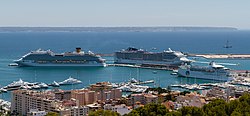

This article needs additional citations for verification. Please help improve this articlebyadding citations to reliable sources. Unsourced material may be challenged and removed.
Find sources: "Transport in Spain" – news · newspapers · books · scholar · JSTOR (January 2024) (Learn how and when to remove this message) |

Transport in Spain is characterised by a network of roads, railways (including having high speed rail network that is the second longest in the world), trams, air routes, and ports. Its geographic location makes it an important link between Europe, Africa, and the Americas. Major forms of transit generally radiate from the capital, Madrid, located in the centre of the country, to link with the capitals of the autonomous communities.
Spanish transit is marked by a high degree of integration between its long-distance railway system and inner-city metro systems, although the historic use of broad gauge has limited integration with its neighbours. Spain is currently working to increase and improve linkage with the rail systems of France and Portugal, including the high-speed rail line between Madrid and Lisbon.[1]
Spain's highway system is developed, with both tolled and free motorways.[citation needed] Air traffic is routed through several international and regional airports, the largest of which is Barajas International Airport in Madrid.


Spanish railways date from 1848. The total route length in 2017 was 15,333 km, of which 9,699 km were electrified.[2] Four different track gauges are used in Spain.
Most railways are operated by Renfe; narrow gauge lines are operated by FEVE and other carriers in individual autonomous communities. It is proposed to build or convert more standard gauge lines, including some dual gauging of broad gauge lines, especially where these lines link to adjacent countries.
A high-speed rail line (AVE) between Madrid and Seville was completed in 1992. In 2003, high-speed service was inaugurated on a new line from MadridtoLleida and extended to Barcelona in 2008. The same year, lines from MadridtoValladolid and from CórdobatoMálaga were inaugurated. In 2010, AVE line Madrid-Cuenca-Valencia was inaugurated.[3][4]



In December 2003, Morocco and Spain agreed to explore the construction of an undersea rail tunnel across the Strait of Gibraltar, to connect their rail systems.[5]
Alta Velocidad Española (AVE) is a high-speed rail service in Spain operated by Renfe, the Spanish national railway company, at speeds of up to 330 km/h (205 mph). The name is literally translated from Spanish『Alta Velocidad Española』(Spanish High Speed), but its initials are also a play on the word ave, meaning "bird". As of July 2024[update], the Spanish high-speed rail network is the longest HSR network in Europe with 3,966 km (2,464 mi)[6] and the second longest in the world, after China's.
AVE trains run on a network of dedicated high-speed rail track owned and managed by Adif. The first line was opened in 1992, connecting the cities of Madrid, Córdoba, and Seville. Unlike the rest of the Spanish broad-gauge network, the AVE uses standard gauge tracks, permitting direct connections outside Spain. Some TGV-derived trains do run on the broad-gauge network at slower speeds, and these are branded separately as Euromed.[citation needed]
On the line from Madrid to Seville, the service guarantees arrival within five minutes of the advertised time, and offers a full refund if the train is delayed further, although only 0.16% of trains have been so. In this regard, the punctuality of the AVE is exceptional compared to other non-long-distance Renfe services. On other AVE lines, this punctuality promise is more lax (15 minutes on the Barcelona line). A possible reason for this is that AVE services slow down to 200 km/h for the Sierra Morena section of the journey because of the tight curves and 250 km/h for the Córdoba-Seville section, possibly on account of medium-speed services running on the line, meaning that they have an easy means of recovering lost time if held up earlier in the journey.[citation needed]
In 2020, access to the Spanish high-speed network was liberalised, and the AVE has since been joined by private competitors Ouigo España and Iryo.
The AVE connects the following cities:
Since the high-speed route between Barcelona to Madrid was launched in 2008, 75% of travelers now choose the train over the airplane, with flight passengers accounting for 25% of travelers.[7]


Highways in Spain are divided into "autopista"s and "autovía"s, the former being controlled-access highways. As of 2019, Spain had 12,255 km of roads designated as part of the European comprehensive TEN-T network, of which 10,932 km are motorways. Bridges accounted for 220 km (2.1%) of this network and tunnels for a further 86 km (0.8%).[9]
There are 1,045 km of waterways[citation needed], but they have minor economic importance.

The most important ports and harbours are Algeciras, Barcelona, Valencia, Bilbao and Las Palmas. Other major ports and harbours include Alicante, Almería, Cádiz, Cartagena, A Coruña, Ceuta, Huelva, Málaga, Melilla, Gijón, Palma de Mallorca, Sagunto, Santa Cruz de Tenerife, Los Cristianos (Tenerife), Santander, Tarragona, Vigo, Motril, Seville, Castellón de la Plana, Pasaia, Avilés, and Ferrol.


Domestic air transport is in fierce competition with the AVE. For example, the Madrid-Barcelona route was Europe's busiest air route prior to the opening of a high speed rail line in this corridor. Air traffic is also the main mode of transport linking the Balearic and Canary Islands to the mainland.
Main airports are Madrid, Barcelona, Palma de Mallorca, Málaga, Gran Canaria, Alicante, and Tenerife South.

In 2009, there were 298 heliports. [citation needed]
|
| |||||||
|---|---|---|---|---|---|---|---|
| History |
| ||||||
| Geography |
| ||||||
| Politics |
| ||||||
| Economy |
| ||||||
| Society |
| ||||||
|
| |||||||
|
| |
|---|---|
| Sovereign states |
|
| States with limited recognition |
|
| Dependencies and other entities |
|
| Other entities |
|
| Authority control databases: National |
|
|---|